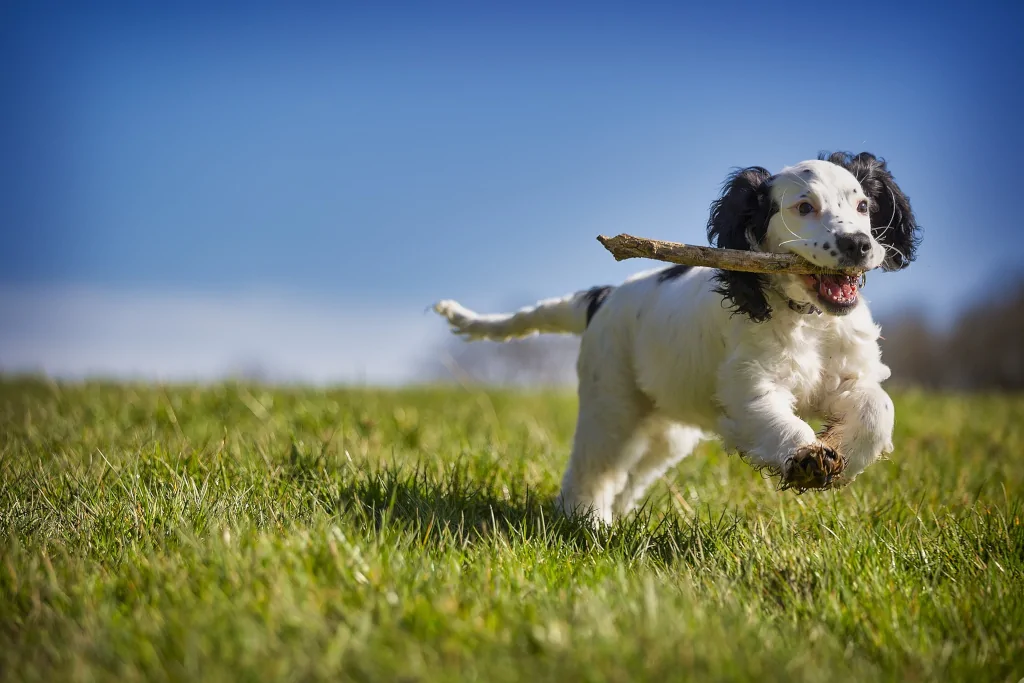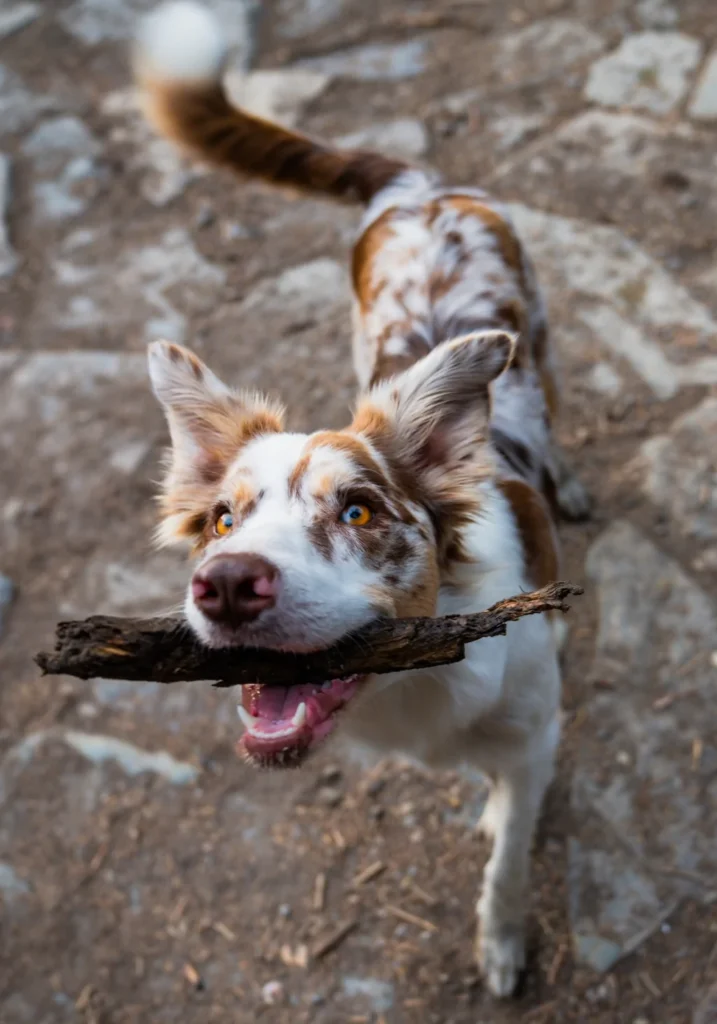Disclosure: We may earn a commission from helpful, relevant links in our content. No cost to you. See our privacy policy.
Playing fetch with your furry friend can bring joy and laughter, but sometimes it can feel like a chore if your dog doesn’t cooperate or simply gets bored.
You might be wondering how to make this classic game more engaging for both you and your canine companion.
In this blog post, we’ll unlock the secrets to transforming fetch into a fun, rewarding, and stimulating activity you’ll both enjoy.

Why Is Fetch a Fantastic Game for Dogs and Owners?
Fetch is an incredible game for dogs and owners because it not only provides physical exercise but also stimulates your dog’s mind and reinforces your bond.
A well-executed game of fetch can help your pup burn off excess energy, making them calmer and better behaved at home.
Moreover, it’s a fantastic way for you to spend quality time together and enjoy the great outdoors. Now let’s get started with the right toy.
Choosing the Right Toy for a Successful Game of Fetch
Choosing the perfect toy for a game of fetch is crucial for a successful and enjoyable experience.
Consider your dog’s size, preferences, and play style when selecting a toy. Some dogs may prefer soft toys like plush animals, while others might be more interested in balls or Frisbees.
For example, a durable rubber ball like the Kong Classic is suitable for strong chewers, while a soft, squeaky toy like the ZippyPaws Skinny Peltz might be ideal for dogs that enjoy carrying around a cuddly companion.
Opt for a toy that is easy for your dog to pick up and carry, yet durable enough to withstand their enthusiastic play.
Don’t forget to keep safety in mind – avoid toys with small parts that can be swallowed, and regularly inspect them for wear and tear.
Here are some of the suggested toys relative to your dog breed and size:
| Dog Breed/Size | Preferences | Toy Suggestions |
| Small | Soft, lightweight | ZippyPaws Skinny Peltz, or small Kong Classic |
| Medium | Durable | Medium Kong Classic, or Chuckit! Ultra Ball |
| Large | Heavy chewers | Kong Extreme, or Goughnuts Indestructible Ring |
A well-chosen toy can make all the difference in your fetch game, ensuring endless fun for both you and your pup.
Read more: How to Choose the Right Training Toy for Your Dog
Teaching Your Dog to Fetch: A Step-By-Step Guide
Step 1: Introduce the Toy
Start by introducing the toy you’ve chosen for the fetch game. Allow your dog to sniff, bite, and play with it, building their interest in the toy. You can also use this time to praise and reward your dog for interacting with the toy, creating a positive association.
Step 2: Encourage Chasing
Once your dog is interested in the toy, gently toss it a short distance away. Encourage your dog to chase after it by using verbal cues like “fetch” and pointing to the toy.
If your dog runs towards the toy, praise them enthusiastically. If they’re hesitant, you can try running toward the toy with them to boost their confidence.
Step 3: Retrieving the Toy
When your dog reaches the toy, praise them for getting close to it. If they don’t pick it up, try using a more enticing toy, or encourage them with verbal cues and hand gestures.
Once they pick up the toy, cheer them on and call them back to you using their name and commands like “come/here”.
Step 4: Delivering the Toy to You
As your dog returns to you with the toy, encourage them to bring it all the way back. If they drop the toy too soon, point to the toy and say “bring it” or “fetch” to prompt them to pick it up again. Reward your dog with praise and treats once they bring the toy to you.
Step 5: Releasing the Toy
To teach your dog to release the toy, use a command like “drop it”, or “give”. You can hold a treat close to their nose to encourage them to release the toy in exchange for the treat.
Once your dog releases the toy, reward them with the treat and praise.
Step 6: Gradually Increase Distance and Difficulty
As your dog becomes more proficient at fetch, gradually increase the distance you throw the toy and introduce more challenging environments, such as varying terrain or obstacles.
This will keep the game exciting and challenging for your dog, ensuring they remain engaged and enjoy the activity.
Remember to always practice patience and consistency while teaching your dog to fetch. It may take some time for them to master each step, but with dedication and positive reinforcement, you’ll have a fetching pro in no time!

Addressing Common Fetch-Related Challenges
Challenge 1: Dog Loses Interest in the Toy
Solution: Rotate toys to keep your dog engaged, and choose toys that appeal to your dog’s individual preferences. You can also try toys that make noise or have a treat-dispensing feature to maintain their interest.
Challenge 2: Dog Refuses to Bring the Toy Back
Solution: Reinforce the “come/here” command separately from fetch, ensuring your dog understands and follows the command. Use high-value treats to reward your dog when they return to you with the toy.
You can also try playing fetch with a second toy, throwing it once your dog returns with the first one, creating a cycle that encourages them to bring the toy back to you.
Challenge 3: Dog Won’t Drop the Toy
Solution: Teach the “drop it” command independently from fetch. Practice with different toys and objects, rewarding your dog when they release the item. During fetch, use treats or another toy to encourage your dog to release the fetched toy.
Challenge 4: Dog Becomes Possessive Over the Toy
Solution: Train your dog to understand that sharing the toy results in a fun game. Encourage them to release the toy using treats and praise, reinforcing the idea that giving up the toy leads to a positive outcome. If your dog continues to be possessive, consult a professional dog trainer for guidance.
Challenge 5: Dog Tires Quickly or Loses Focus
Solution: Keep fetch sessions short and sweet, especially in the beginning. Gradually increase the duration and intensity of the game as your dog builds stamina and focus. Remember to consider your dog’s breed, age, and physical abilities when determining the appropriate intensity and duration for a game of fetch.
Making Fetch a Regular Part of Your Dog’s Routine
Incorporating fetch into your dog’s daily routine can be a rewarding experience for both you and your furry friend.
I remember when I started playing fetch with Sam, my well-trained dog, in the backyard every evening. Sam would eagerly anticipate our play sessions, waiting by the back door with his favorite squeaky toy.
The excitement in his eyes and wagging tail brought so much joy to my heart, knowing that our fetch routine was not only a great way to bond, but also an excellent source of exercise for him.
Here’s a video from Training Positive that suggests starting with teaching your dog the “Take it” command first. Give it a shot, it just might work better for you!
FAQs
Can fetch be played indoors or in a small space?
Fetch can be adapted for indoor play or small spaces by using soft, lightweight toys, such as the Kong Air Squeaker Tennis Balls, and reducing the distance you throw the toy. Ensure the area is clear of breakable objects and hazards before starting the game.
How do I teach my dog to drop the toy after fetching?
Teach your dog the “drop it” command separately from fetch, using treats or praise as a reward when they release the toy. Gradually incorporate this command into your fetch sessions. A similar “give” command is also an option.
Is fetch suitable for all dog breeds and sizes?
Fetch is suitable for most dog breeds and sizes, but consider each dog’s physical abilities, age, and breed-specific limitations. For example, brachycephalic breeds, like Bulldogs and Pugs, may struggle with breathing during intense play, so keep fetch sessions shorter and less strenuous for them.
Can I use fetch as a form of exercise for my dog?
Yes, fetch is an excellent form of exercise for dogs, providing physical activity, mental stimulation, and an opportunity to burn off excess energy. However, always consider your dog’s breed, age, and fitness level when determining the intensity and duration of fetch sessions.
Alex, a passionate animal lover, has experience in training and understanding animal behavior. As a proud pet parent to two dogs and three cats, he founded AnimalReport.net to share insights from animal experts and expand his knowledge of the animal kingdom.




